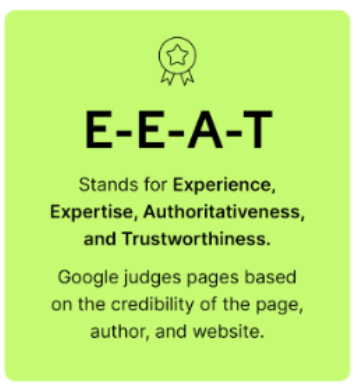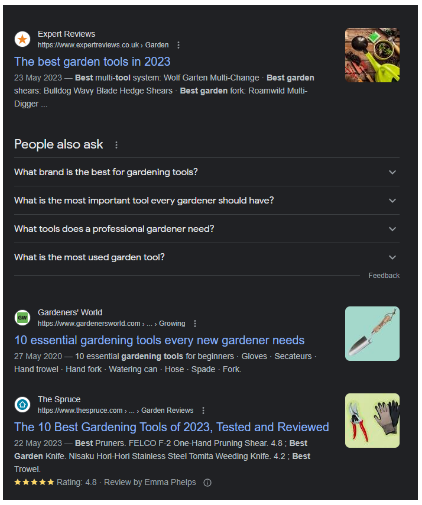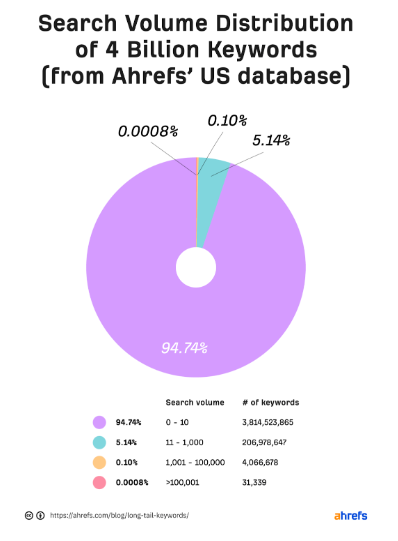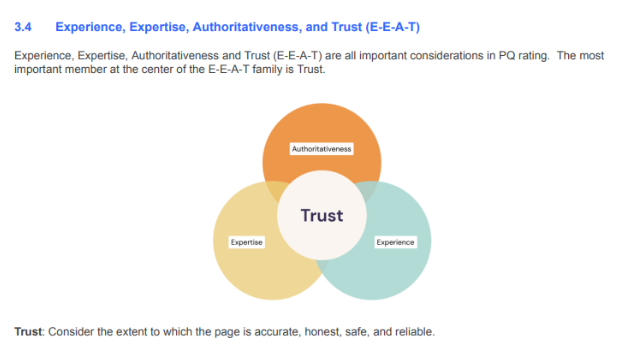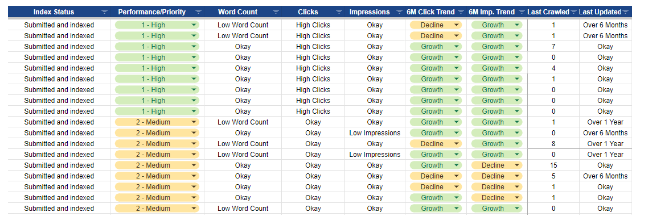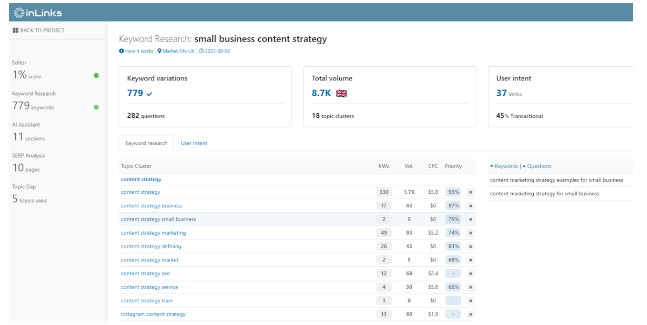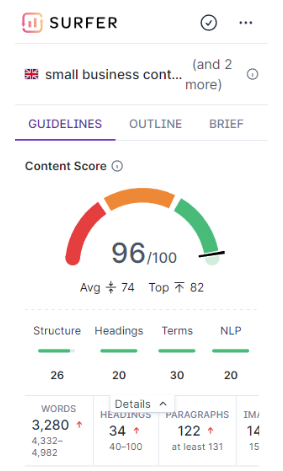How To Create a Small Business Content Strategy

Content is king, as they say, and for good reason.
As a small business owner, your content drives traffic to your website, cultivates customer trust, and positions your business as an authority in its industry.
But, without a solid content strategy? It’s like throwing spaghetti at a wall and seeing what sticks.
Creating an effective SEO content strategy is crucial for small businesses. It’s a roadmap for attracting potential customers, building brand reputation, and generating valuable leads.
So, how can you craft a content strategy that drives results? Here are some expert insights from Dandy’s Content Manager…
What is small business content marketing?
Small business content marketing is the process of planning, developing and executing content with the aim of attracting new customers and boosting brand awareness.
This approach taps into the power of quality content that resonates with your target audience’s needs and interests.
It’s not just about selling a product or a service, it’s about providing value, solving problems, and establishing a solid foundation of trust with your customers.
Ultimately, effective content marketing is a long-term investment that brings tangible returns for small businesses. Whether you’re a local chiropractor or looking to grow your eCommerce business.
Content marketing ideas can range from:
- Blogging and SEO: Writing blog posts and optimising them for search engines is the cornerstone of an effective SEO content strategy.
- Social media platforms: Social media posts are an excellent platform to reach new customers, engage with existing ones, and build relationships. It also provides opportunities for user generated content, which can be great for engagement.
- Email marketing: This is especially valuable for small businesses, as it allows you to quickly and easily reach your target audience with personalised messages.
- Infographics: Infographics are highly shareable visual content that can break up complex topics into easy-to-understand graphics. You can take data for pretty much any industry for this type of content, so you should never be short on infographic ideas.
- Video content: Videos are a great way to capture attention and convey your message quickly and effectively.
What is an SEO content strategy?
An small business SEO content strategy is a plan designed to help a business rank higher in search engine result pages (SERPs) through SEO-optimised content.
The right strategy increases your website’s visibility, bringing in more traffic to convert into customers.
Through search engine optimization, content marketing efforts take on a new lease of life. After all, why would you want to fill your website—or waste your valuable time—with opinion-pieces that are never going to be found?
For small business owners in particular, a strong SEO content marketing strategy can be a true game changer.
Picture this: you’re considering investing in a new product or service.
Before you shell out your hard-earned money, what do you do? Chances are, you’ll head to Google.
And from there, you’ll probably click through to a website on the first page to answer any questions you might have.
This is precisely what an SEO content strategy aims to do: get your business ranking on the first page of Google for the search queries that are relevant to your product.
It makes it easier for customers to find you online—and then encourages them to purchase from you.
Creating content for SEO in 2024
In 2023, content creation for SEO will leverage the power of AI like never before.
Generative AI models, such as Google’s soon-to-launch SGE (Search Generative Experience) have the potential to revolutionise the way SEO content works.
Google’s AI system will have the ability to generate human-like text, creating engaging, readable content that answers the reader’s question at speed—right, from the SERP.
At the same time, Google’s E-E-A-T (Experience, Expertise, Authoritativeness, Trustworthiness) update in 2022 made it clear that direct experience, authority and credibility are key.
Remember, at its core, Google is all about user experience. It wants to provide its users with the best possible content to answer their search queries.
Therefore, your content should be written by someone with direct expertise in the field, or someone with the capacity to conduct thorough research and create authoritative and trustworthy content that emulates direct experience in the field.
It should provide insightful information that’s both accurate and useful.
Furthermore, Google’s Helpful Content Guidelines reiterate the importance of creating content that is genuinely helpful to the user.
It’s not just about plugging in keywords anymore; it’s about considering the intent behind those keywords and crafting content that meets the needs of the searcher.
That means understanding your audience, predicting their questions, and providing clear, concise answers.
So, as you embark on your content creation journey for 2023, remember: quality, relevance, and user experience should be at the heart of your SEO content strategy.
Key pillars of a small business SEO content strategy
Understanding of search intent
Search intent is about understanding why someone is searching for a particular keyword. The four types of search intent are informational, navigational, transactional, and commercial investigation.
For example, a user searching for “best gardening tools” likely intends to compare options (commercial investigation), not to buy immediately (transactional). Notice how the top ranking pieces here are also blog articles:
Assessing each SERP for intent, and then tailoring your content to match that intent can boost your rankings. For example, for the above keyword, you might create a blog post comparing various gardening tools rather than a product page.
Tools to define search volume
Search volume, the number of times a specific keyword is searched over a given period, is also pivotal. High search volume keywords can drive more traffic. But remember, they also have higher competition. So a mix of different sized opportunities is usually best for any small business getting started with SEO content.
For small businesses, it’s often a good idea to focus on long-tail keywords, which have less search volume but also less competition.
For instance, instead of “gardening tips,” a long-tail keyword more suitable for a small business might be “gardening tips for beginners in spring.”
In order to find the search volume of different keywords and queries, you will need access to SEO tools like AHRefs, InLinks, KeywordsEverywhere, or others, which often come at a monthly premium.
Topic clusters
Topic clusters are fundamental to a strong small business SEO content strategy.
They consist of a core topic (pillar content) and a series of related subtopics (cluster content) linked together through hyperlinks.
This structure helps search engines understand your content better, improving your rankings and visibility.
For instance, if you run a small gardening business, your pillar content might be “Gardening Tips.” Its cluster content could include “Tips for Growing Roses,” “How to Prune Trees,” and so on.
This structure not only enhances your site’s organisation but also keeps visitors engaged longer, which positively impacts SEO.
Topical authority, direct experience, and inside expertise
Three key factors play a role in creating SEO-friendly content that’s in line with Google’s E-E-A-T guidelines:
- Topical authority refers to your authority in a particular subject matter. The more knowledgeable you are about a topic, the more accurately and comprehensively you can write about it. This depth of knowledge often leads to content that is informative, engaging, and highly valuable to readers—which builds topical authority in your sector.
- Direct experience, meanwhile, is the hands-on understanding you gain from actively participating in or observing something. For example, a gardener who has spent years cultivating various plants and managing different landscapes can provide unique insights, tips, and advice based on their direct experiences.
- Insider expertise builds on this, and is the specialised knowledge or skill gained through extensive experience or study in a particular field. For instance, a horticulturist’s insights into plant physiology, pests, and diseases would be considered inside expertise.
Using these three elements as the foundation of your SEO content strategy will not only help you create quality content that resonates with your audience but also improve your credibility, trust and authority.
Quality content writers
Creating quality content requires quality writers.
You should look for writers who are knowledgeable and experienced in SEO blog writing, understand your brand’s voice, and can craft content that resonates with your target audience.
They should have the ability to research topics thoroughly, identify gaps in content, and use compelling language to engage readers.
Your writers should be able to take your knowledge, experience and expertise in your field and craft engaging stories that are optimised for SEO, helping your content reach a wider audience.
Blog category on website
Blogging is an important part of a content strategy. It helps boost organic reach, drive traffic to your website, and increase conversions.
Creating a separate blog category on your website also ensures that readers can easily access information about your products and services as well as other relevant topics.
This makes it easier for search engines to crawl and index the pages, thus boosting your SEO.
Moreover, having a dedicated blog section on your website also helps you build relationships with your readers and establish yourself as an authority in the field.
Access to GA & GSC
To effectively measure the current state of your SEO and content performance, and audit your future efforts, you will need access to search tools like Google Analytics (GA) and Google Search Console (GSC).
GA and GSC not only provide you with insights into how your content is performing on search engines but also give you detailed analysis of website traffic, average session duration, organic reach, and other key elements.
This data can help you make informed decisions about future content creation for SEO optimization.
How to create a small business content strategy in 10 steps
Step 1: Set your goals
Start by setting clear, measurable goals. What do you want your content to achieve?
If you’re looking to increase website traffic, for example, you might measure success by the number of monthly visitors or page views for each piece of content you put out.
If direct conversions or goal completions are your top priorities, you may measure success through conversion rate or number of goal completions that can be attributed to blog content over a period of time.
Other goals to consider include:
- What products or services are going to be the priority call-to-actions for your content? Knowing your priorities here will help you curate relevant content to your wider sales goals.
- What problem does your product or service solve for your target audience? What key USPs do you want to communicate through your content?
Step 2: Know your audience
Understanding your audience is key.
What are they searching for? What are their pain points? What content do they engage with? What do they need to know? What problems and challenges are currently blocking them from getting what they need?
Consider using surveys, social listening, and even direct conversations to get the insight you need.
Or—use your own industry expertise to brainstorm your ideal audience, and lay out what questions and problems they may encounter.
How can your content answer those questions or fix those problems?
A clearly defined audience allows you to develop more personalised and valuable content that not only suits that ideal audience, but is designed specifically for them.
Step 3: Audit your current content
If you’ve been posting content on your website with no strategy in mind, no matter how well-intentioned your efforts have been, you’re going to need to take stock of what you’ve got.
Look at your existing content and evaluate it against your goals.
Which pieces are performing well? Which are falling short? You can then use this information to guide your strategy efforts and generate fresh content ideas.
Content audits are the perfect way to assess this. They can be a lengthy and technical process, but boy are they worth it.
By auditing the current performance of the content on your website, you can:
- Chop any dead weight or unhelpful content (yes, that’s a real thing) that Google might be flagging and penalising your website for.
- Discover the highest performing content you currently have to guide wider marketing efforts.
- Schedule updates and refreshes for any outdated or underperforming content with SERP potential.
These opportunities provide an informed foundation for your content plan.
Grab a free SEO audit today to get started or view our SEO packages.
Step 4: Competitor analysis and content gap identification
Next up, you’re going to want to get a sense of what competitors in your space are doing.
Analyse the top players in your industry—for both success and search engine authority.
As a small business, the golden opportunities here are where you can find other smaller businesses up in the top of the SERP.
Competitor analysis gives you the insights into what topics are being talked about, what keywords they’re targeting, and how successful content is being framed.
Once you have this data, you can identify any gaps in their content—topics that haven’t been explored in depth or areas for improvement.
This can also feed into your content ideas list.
Step 5: Keyword research (with InLinks)
The next phase of building an SEO content strategy is keyword research. This step helps you identify the keywords your potential customers are using to find businesses like yours.
A tool such as InLinks Keyword Research can provide you with crucial keyword data, such as search volume, competition level, and search intent.
By inputting one seed keyword into this tool, you can gather hundreds, sometimes thousands, of related keywords and data.
Take a look at our example below:
Start with 1 to 3 pillar keywords, and export the keyword data into a content plan sheet.
Step 6: Build topic clusters (with KeywordInsights)
Next, use a tool like Keywords Insights to automate the development of strong topic clusters around your researched keywords.
This tool will help you identify related subtopics to create cluster content around your pillar content, enhancing the organisation of your site while engaging your site visitors for longer.
As you build your clusters, ensure that the content you create meets the search intent (or context) of your target audience. For blogs, this will usually be informational—that’s the goal here, anyway!
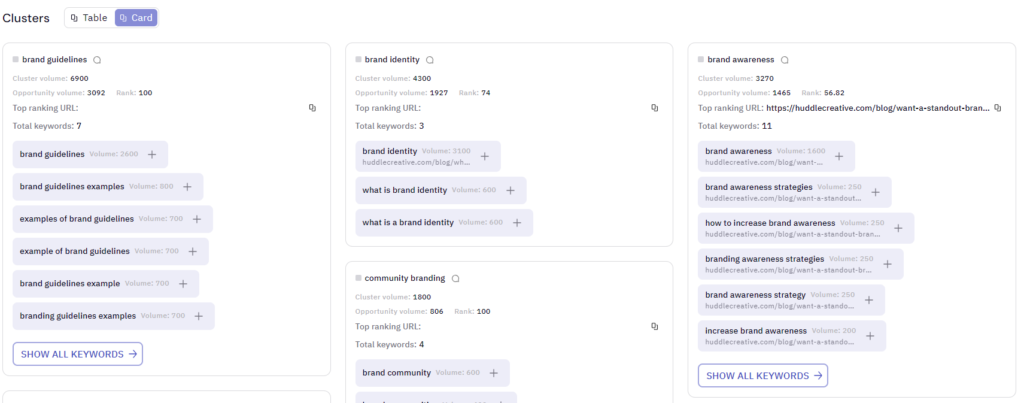
This tool is great, as it emails your cluster data directly to you in a GoogleSheet, ready to go.
From here, you have all of your keyword clusters in one place, ready for the next steps in building your strategy.
Step 7: Develop a content plan & content calendar
Take it from someone that manages the content of 20+ clients day in, day out: a content calendar is going to be your best friend.
It helps keep you on track, ensuring you consistently publish high-quality content.
Plus, it allows you to plan around key dates or events in your industry. Now that you have your keyword clusters, building a content plan is much simpler.
Create blog titles for each keyword and cluster, and consider how each piece of content will fit into your wider goals.
When mapping out your content plan into a content calendar, it’s always a good idea to include the keyword, topic/title, content status, and other key details for each piece of content—especially if you’re outsourcing your content creation to third-party content writers.
These calendars help keep you on track with your objectives and help you better manage your content strategy.
Here’s an example content calendar from Dandy, where you can clearly see our core topic, keyword cluster, publish month, and title for each piece of content:
Step 8: Content creation
Armed with your keywords and topic clusters, you can now begin to create content.
Focus on providing value and answering your audience’s questions, and be sure to incorporate your keywords naturally to avoid keyword stuffing.
Remember that search engines prioritise high-quality, informative content over content that’s merely packed with keywords.
Search engine marketing has come a long way since those early days. You need to provide value to your reader.
Look for SEO content writers who can effectively research your industry and write content that will attract, engage and convert your audience.
A good writer is worth their weight in gold when it comes to SEO.
Step 9: SEO optimization with SurferSEO
Once your content is ready, use a tool like SurferSEO and the InLinks content editor to ensure it’s fully optimised for search engines.
SurferSEO can help you optimise your page structure, headings, terms used and more, based on the top-ranking pages for your chosen keywords.
This tool can provide you with actionable recommendations to improve your site’s SEO performance.
Step 10: Track impact and adjust your strategy
Finally, continuously track your progress and make adjustments as needed. SEO is a long-term strategy that requires monitoring, testing, and tweaking.
Use a tool like Google Analytics to track your site’s traffic, bounce rate, and other metrics that indicate whether your business content marketing strategy is working as intended.
Remember, creating an effective SEO content strategy is a process that requires time, patience, and dedication.
But with the right tools and approach, you can make significant strides in improving your small business’s online visibility and customer reach.
SEO content strategy statistics
To back up the importance of SEO content strategy, here are a few statistics to consider:
- The top 3 Google Search results get 54.5% of all clicks.
- The number one spot on Google search result pages (SERPs) receives at least a quarter of the organic traffic share, so investing in SEO can even the playing field against your top competitors.
- The #1 result in Google’s organic search results has an average CTR of 27.6%, and is 10x more likely to receive a click compared to a page in the 10th spot.
- Inbound dominated marketing (like blogs, SEO, and PPC) offer a 60% lower cost per lead than outbound dominated marketing.
- According to Semify’s ROI of SEO Calculator, the ROI of SEO can skyrocket up to 4722.2% shortly after a year, when compared to month 1. See below.

Bring your small business content strategy to life today with Dandy.
Of course, you can create your own small business content strategy—especially with handy expertise like this to hand to help guide you.
However, for a truly effective SEO content strategy, you’re best leaving it to the real experts.
SEO agencies often provide dedicated, experienced content teams that live and breathe high-quality content.
From audits and content strategy through to content creation, optimization, and ongoing content impact analysis, SEO professionals provide the inside scoop and manpower you need to succeed.
Grab a free SEO audit today to get started.
Content strategy for small businesses: FAQs
Why do content marketing for small businesses?
Content marketing is essential for small business success. It allows you to connect with your target audience, build brand awareness and trust, and drive more organic traffic (and potential customers) to your website.
What are the pillars of content strategy?
Key pillars of content strategy include: a working knowledge of search volume and intent; targeted topic clusters; authority, experience, and expertise in your industry; quality content writers; a blog category on your website; and access to tools such as GA, GSC, and content optimisation tools.
What are the steps in creating a content strategy?
As we outlined above, the steps to creating an effective SEO content strategy are as follows:
1. Set your goals
2. Know your audience
3. Audit your current content
4. Complete competitor analysis
5. Keyword research
6. Building topic clusters
7. Develop content plans and calendar
8. Content creation
9. SEO optimisation
10. Track impact & implement adjustments.


